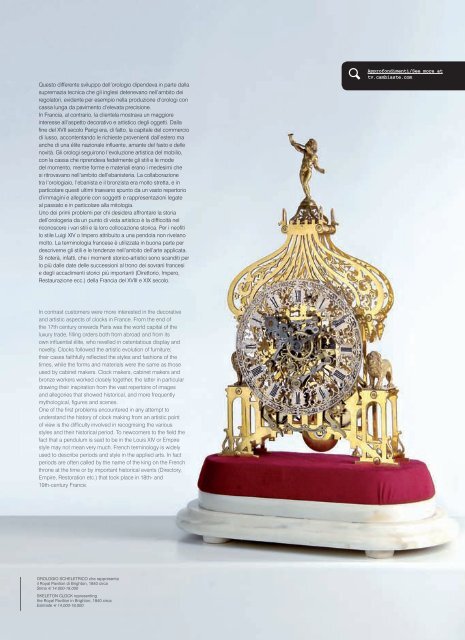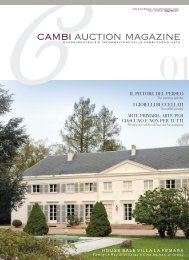You also want an ePaper? Increase the reach of your titles
YUMPU automatically turns print PDFs into web optimized ePapers that Google loves.
Questo differente sviluppo dell’orologio dipendeva in parte dalla<br />
supremazia tecnica che gli inglesi detenevano nell’ambito dei<br />
regolatori, evidente per esempio nella produzione d’orologi con<br />
cassa lunga da pavimento d’elevata precisione.<br />
In Francia, al contrario, la clientela mostrava un maggiore<br />
interesse all’aspetto decorativo e artistico degli oggetti. Dalla<br />
fine del XVII secolo Parigi era, di fatto, la capitale del <strong>com</strong>mercio<br />
di lusso, accontentando le richieste provenienti dall’estero ma<br />
anche di una élite nazionale influente, amante del fasto e delle<br />
novità. Gli orologi seguirono l’evoluzione artistica del mobilio,<br />
con la cassa che riprendeva fedelmente gli stili e le mode<br />
del momento, mentre forme e materiali erano i medesimi che<br />
si ritrovavano nell’ambito dell’ebanisteria. La collaborazione<br />
tra l’orologiaio, l’ebanista e il bronzista era molto stretta, e in<br />
particolare questi ultimi traevano spunto da un vasto repertorio<br />
d’immagini e allegorie con soggetti e rappresentazioni legate<br />
al passato e in particolare alla mitologia.<br />
Uno dei primi problemi per chi desidera affrontare la storia<br />
dell’orologeria da un punto di vista artistico è la difficoltà nel<br />
riconoscere i vari stili e la loro collocazione storica. Per i neofiti<br />
lo stile Luigi XIV o Impero attribuito a una pendola non rivelano<br />
molto. La terminologia francese è utilizzata in buona parte per<br />
descriverne gli stili e le tendenze nell’ambito dell’arte applicata.<br />
Si noterà, infatti, che i momenti storico-artistici sono scanditi per<br />
lo più dalle date delle successioni al trono dei sovrani francesi<br />
e degli accadimenti storici più importanti (Direttorio, Impero,<br />
Restaurazione ecc.) della Francia del XVIII e XIX secolo.<br />
In contrast customers were more interested in the decorative<br />
and artistic aspects of clocks in France. From the end of<br />
the 17th century onwards Paris was the world capital of the<br />
luxury trade, filling orders both from abroad and from its<br />
own influential élite, who revelled in ostentatious display and<br />
novelty. Clocks followed the artistic evolution of furniture;<br />
their cases faithfully reflected the styles and fashions of the<br />
times, while the forms and materials were the same as those<br />
used by cabinet makers. Clock makers, cabinet makers and<br />
bronze workers worked closely together, the latter in particular<br />
drawing their inspiration from the vast repertoire of images<br />
and allegories that showed historical, and more frequently<br />
mythological, figures and scenes.<br />
One of the first problems encountered in any attempt to<br />
understand the history of clock making from an artistic point<br />
of view is the difficulty involved in recognising the various<br />
styles and their historical period. To new<strong>com</strong>ers to the field the<br />
fact that a pendulum is said to be in the Louis XIV or Empire<br />
style may not mean very much. French terminology is widely<br />
used to describe periods and style in the applied arts. In fact<br />
periods are often called by the name of the king on the French<br />
throne at the time or by important historical events (Directory,<br />
Empire, Restoration etc.) that took place in 18th- and<br />
19th-century France.<br />
OrOLOGIO sCheLeTrICO che rappresenta<br />
il royal Pavilion di Brighton, 1840 circa<br />
Stima e 14.000-18.000<br />
sKeLeTON CLOCK representing<br />
the royal Pavilion in Brighton, 1840 circa<br />
Estimate e 14,000-18,000<br />
Approfondimenti/See more at<br />
tv.cambiaste.<strong>com</strong>




